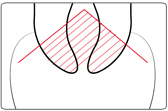Breast surgery
Adnexa surgery
Uterine surgery
Cervical surgery
Vulvar surgery
Other
Conization
A conization consists to remove a cone-shaped wedge of tissue from the cervix.
Why having a conization

This surgery is performed when abnormal cells from the cervix (called cervical intraepithelial neoplasia type 2 or 3 – CIN II, CIN III) have been detected further to cervical smear (Pap test). The abnormal cells are then localized by colposcopy and diagnosed by biopsy.
If no treatment is engaged, those lesions can lead to a cervical cancer: they can thus be considered as precancerous cells.
The surgery is performed with two main objectives:
- Diagnosis: the exact type of cervical lesions will then be determined, as well as extent of damaged tissue.
- - Therapeutic: it allows the complete removal of the abnormal cells, and thus prevents any cervical cancer evolution.
Conization is performed under local anesthesia. In some cases, an epidural block or a spinal anesthesia is practiced.
Surgery procedure
To perform the conization, the surgeon will use natural openings, i.e. vagina, cervix.
It is performed with a thin metallic electric wire, allowing to cut and to coagulate in the meantime.
Preparation for this surgery may take 10 to 15 minutes, but the surgery act by itself will only last a few seconds.
This surgery can be done as an outpatient procedure; you will be able to leave the clinic 30 minutes after the surgery. No work leave need to be planned.
Risks & Complications
In spite of the meticulous surgery technics, it is not possible to guarantee neither therapeutic success nor a total absence of any complications.
During the surgery
Blood loss: it may exceptionally lead to a blood transfusion or another surgery in emergency.
Post-operative
- Some vaginal bleeding is normal, up to 10 days after the surgery; If a massive blood loss happens, a vaginal mesh can be installed. It may also require another surgery, in order to secure hemostasis (either by coagulation or with stitches). It may rarely lead to a blood transfusion.
- Cervical stenosis: means that the opening in the cervix is narrower than typically. This can happen once the scar process is finished, i.e. quite a long time after the surgery. This stenosis may need a dilatation, and in some cases, a new surgery.
- Risk of premature delivery and miscarriage: There is a small risk of premature delivery and miscarriage once a conization has been performed. This risk may lead to have more rest during any future pregnancy.
Last update: 10/2/2013
